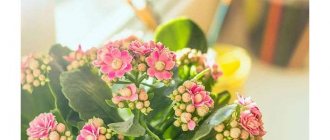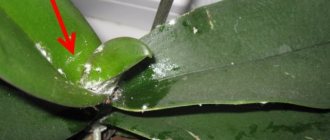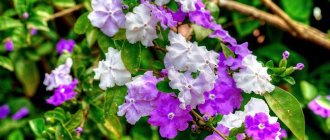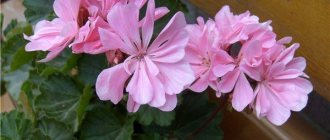The colony of greenish-black insects on the plant is hard to miss. Aphids on orchids, as well as on other indoor flowers, reproduce according to the principle of geometric progression. One adult female is capable of producing from 60 to 100 larvae per day, so the fight against this pest cannot be postponed until tomorrow. How to save an orchid from aphids?
Aphids belong to the order of hemipteran insects, numbering about 4 thousand species, of which about 1 thousand varieties are found in Europe. Most of them are malicious pests of plants, capable of not only destroying them by sucking out the juices, but also carrying dangerous viral diseases and causing various gall-shaped growths.
Appearance of aphids
The size of insects is only a few millimeters. Representatives of each species feed through a proboscis, which they use to pierce the surface of the leaf plate and draw out the juice. They secrete honeydew, a sticky sweet secretion that is hunted by ants that live in symbiosis with aphid colonies.
In each species, winged and wingless forms can be born, depending on environmental conditions: while they are favorable, the larva turns into an adult without wings, and vice versa, if the colony has nothing to eat, insects with wings appear, flying to other plants in search of food . In some species, reproduction occurs by laying eggs, but there are also viviparous aphids. Many varieties are characterized by parthenogenesis - reproduction without fertilization, scientifically called virgin. In one month, using this method, the female is capable of producing several generations with a total number of about a hundred thousand larvae. For comparison, with bisexual reproduction, several tens of thousands of individuals appear in the third generation.
Types of aphids that parasitize orchids
Peach or greenhouse (Myzus persicae) - partogenetic females about 2.5 mm long, bright green, sometimes with a pinkish tint, widened at the base and slightly swollen towards the end with a finger-shaped tail. Amphigonic, or egg-bearing females up to 2 mm long, cherry-brown in color, thickened hind legs. Males are even smaller, their chest, head and antennae are black, and their abdomen is greenish with dark stripes. The eggs are light green, darkening over time and before the larvae emerge, they are almost black. The optimal temperature for the appearance of peach aphids is 24 degrees Celsius. It affects vanda, cattleya, lycasta, selenipedium and dendrobium.
Beetroot (Aphis fabae) - a body from dark, almost black, to dark green, 1.7–2.7 mm long. The legs and antennae are pale, with black ends. Produces up to 17 generations per season. Reproduction is both parthenogenetic and bisexual. Beet aphids parasitize the inflorescences and buds of dendrobiums, cymbidiums and phragmipediums.
Orchid (Cerataphis orchidearum) - this species has only a parthenogenetic method of reproduction. It lives in greenhouses throughout the northern hemisphere. Constantly accompanied by ants. Primary nymphs are very mobile, secondary nymphs, on the contrary, remain in place and are very similar to whitefly pupae. Their body is dark reddish-brown, almost black, and broadly oval. Adults are about 1.6 mm long with 2 pairs of reticulated wings. It is found on many types of orchids, but is most often seen on the flowers of coelogina and bletilla.
Pest varieties
In total, the aphid family has about 800 species. Small insect up to 3 mm in size.
Several types of pests often appear on orchids:
- Green. Lives mainly in the southern regions where there are peach orchards. From trees, females migrate to a secondary host, including orchids. At risk are dendrobium, vanda, and cattleya.
- Orchid. Found in large greenhouses, watching along with ants. At risk are celogins.
- Bean. Distributed throughout Russia. Has black color. It settles mainly on jasmine, viburnum, quinoa, and thistle. At risk are Cymbidium, Dendrobium, Phragmipedium.
Signs of orchid infestation by aphids
The pest multiplies so quickly that it is impossible not to notice it on the plant. As soon as one individual appears, in a couple of days a whole colony of several hundred insects will already be swarming on the orchid. If an orchid is attacked by an aphid, then first of all it settles on young shoots, at the base of buds and on open flowers, on the underside of leaf blades.
The areas where aphids have settled instantly become covered with sticky honeydew and shine. In addition to all the listed signs, on the surface of the affected area, white scales are clearly visible - dead skin that the insect sheds during development.
The affected orchid slows down its growth and withers, the leaves often turn yellow and curl, the buds either do not open at all or bloom into a deformed flower. Black mold spots are often visible on the sticky secretions of aphids - this is a sooty fungus settling on the plant.
What to do to prevent the parasite from appearing again?
The best way to control pests is prevention. It's much easier than fighting a horde of plant-eating insects. To prevent orchids from getting sick, they need to create favorable conditions on the site.
Orchids grow and develop correctly when these conditions are met.:
- Air humidity. If the orchid grows at home, then the air humidity in the room must be maintained at least 60%.
- Water the flowers correctly; moisture should not stagnate in the buds and leaves. The ideal option would be to spray the leaves and buds on top with cool water and apply moderate root watering.
- Don't ignore the important role of fertilizing. Proper fertilizers will provide orchids with good immunity.
Important! Inspect the flowers every day, this way you will not cause diseases and will be able to eliminate their causes in a timely manner.
The key to healthy orchids is constant monitoring and prevention. If you do not spread diseases and identify pests in time, you will not have to urgently save flowers with chemicals.
Methods for killing aphids on an orchid
If aphids appear on an orchid, then you need to act immediately - wash the plant under a warm shower from sticky honeydew using a solution of laundry soap and isolate it separately from other specimens in the collection. Then decide how to get rid of insects - using folk or chemical means.
Folk recipes
To prevent aphid attacks, place pots with ordinary indoor pelargonium next to the orchids or sprinkle fresh tea leaves on top of the substrate - the insect does not like their smell.
If the infestation is minor, prepare a remedy for aphids on orchids and spray it on plants affected by aphids:
- celandine infusion - a bunch of fresh or dried leaves along with stems are infused in 1 liter of boiled water for 1-2 days;
- infusion of citrus peels - 200–300 g of lemon or orange peels, pour 1 liter of boiling water and infuse in a dark and warm corner for 3 days;
- flea shampoo - dissolve 1 cap in 0.5 liters of water;
- tobacco infusion - use the contents of cigarettes, infuse in 1 liter of water for 24 hours;
- onion infusion - finely chop a medium-sized onion and pour 1 liter of boiling water, seal tightly and leave for about 7-8 hours.
Chemicals
They resort to chemicals when there is already a large population of pests on orchids. How to treat an orchid against aphids? They are destroyed by repeated spraying with insecticides:
- contact action, entering the insect's body through the skin - permethrin, neoron, Roxion D, Neudosan Neu Blattlausfrei, Schadlingsfrei;
- enteric contact, absorbed along with food from the surface of the plant - fitoverm, inta-vir, actara, arrivo, actellik;
- systemic action, penetrating into plant cells and eaten with juice by aphids - Bi 58, Lizetan-Plus-Zierpflanzenspray and others.
It should be noted that during re-treatment it is necessary to use another agent, since aphids quickly get used to the chemical and acquire stable immunity to it. Particular attention should be paid to atomizing preparations that are sold in spray form. The product located inside the can in a compressed state at a short distance from the flower during spraying greatly supercools the surface of the leaves and causes damage to the tissues. Usually, in the instructions for the spray, the manufacturer indicates how far from the plant the sprayer should be held during treatment.
Fighting methods
It is better to fight the pest comprehensively. It is necessary to treat depending on the scale of damage to the flower crop.
Biological and chemical preparations cope well with this task. Moreover, the former have the least toxicity.
Biological products
Leaves must be processed on all sides
Based on the activity of bacteria that are destructive to the pest, biological compounds are not very effective, but are the least safe for plants. They exhibit protective properties after 1.5-2 weeks.
Processing rules:
- the leaves are sprayed from the outside and inside, the stems also need to be treated, while avoiding contact of active substances with the inflorescences;
- Spraying is repeated after 1.5-2 weeks.
The most popular drugs that help remove aphids:
- Fitoverm. Shows effectiveness on the third day after treatment. Provides protection for 2-3 weeks.
- Entobacterin. It acts after 5-7 days, while the concentration of action increases at a temperature of 30°C or more.
- Akarin. It is capable of fighting only certain species, therefore it requires re-treatment after a week.
- Arrow. Systemic spectrum drug. Effective against various pests.
Reasons for appearance
Most often, the cause of parasites is their escape from a neighboring pot. If you do not start fighting aphids on orchids immediately after they appear, then there is a high risk that all plants on the windowsill will be affected. The infected flower should be placed away from all other plant crops, preferably in another room.
The second reason is the creation of favorable conditions for the reproduction of pests. Aphids love environments with dry air. In such conditions, it receives the necessary amount of nutrients for good growth and laying of larvae. But this type of parasite does not survive in heat or excess moisture.
Prevention of infection
To ensure that your phalaenopsis does not suffer from the invasion of aphids and other parasites, you need to follow a number of recommendations:
- Water the orchid regularly at the same time (every 7 days). In winter and autumn, reduce watering.
- Do not allow the substrate to dry out.
- Periodically spray the orchid with a spray bottle, but make sure that moisture does not collect in the leaves or inflorescences.
- Regularly inspect the plant for unwanted symptoms or traces of parasites.
- Orchids that you just recently bought in a store cannot be immediately placed in a common flower garden. Isolate them from other plants for a week and inspect them daily.
- Apply fertilizing only in accordance with the rules and regimen.
- Plant phalaenopsis only in purchased soil and disinfected containers.
Despite their tiny size, aphids can cause serious damage to indoor orchids. This insect feeds on the nutritious sap of phalaenopsis, multiplies quickly and injects toxic compounds into the plant tissue while eating it. You can completely get rid of the hated parasite only with the help of insecticides. However, at the initial stage of infection, some folk recipes and mechanical cleaning can help.
How to treat the soil and roots?
It is recommended to periodically, even for preventive purposes, water the plant with a solution of potassium permanganate, but if it becomes infected, this must be done. You can water the soil in the pot with a solution of biological preparations, but you should not treat the roots with chemicals. An infusion of onion peels helps a lot.
It happens that when orchids are transplanted, characteristic growths caused by aphid infestation are found on the roots. They must be removed immediately and the entire plant disinfected.











